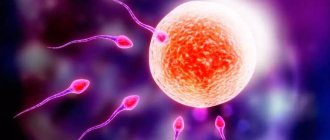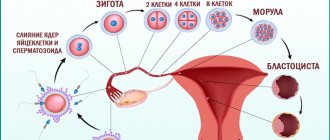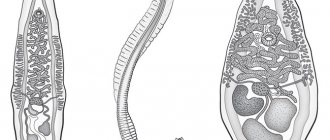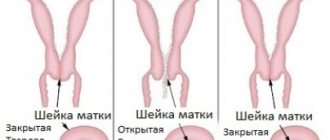What happens after conception
Mother Nature is a wonderful and wise creator. Everything related to procreation is thought out to the smallest detail. Approximately in the middle of the menstrual cycle, a “girl of marriageable age” appears from the ovary - an egg ready for fertilization. It will remain in a state of readiness from 12 to 36 hours. If during this time conception does not occur after sexual intercourse, the egg dies and is excreted from the body along with menstrual bleeding.
It is no secret how egg fertilization occurs. A female cell alone is not enough to generate a new life. The immediate process of conception begins when potential “suitors”—sperm—rush rapidly into the female body. Like heroes from fairy tales and epics, they face a long and dangerous path to their cherished goal.
Let's look at the fertilization of an egg by day. We will consider the first day of the life of an intrauterine baby not the day of sexual intercourse, but the great moment when the sperm meets the egg.
The method of conception - natural or artificial - is discussed with the expectant mother. We think everyone understands the natural method, but the artificial one is possible in two options: at home (sperm is injected into the vagina from a syringe) and in the clinic (IVF).
How to conceive a child?
08/30/2012 Print
Every person at some point in life realizes that they are ready to become a parent. For some people it happens right away, but for others the process is delayed. And the future mother and father begin to worry...
How to conceive a child? Both men and women certainly need to prepare for this. First of all, you need to calm down, not think only about your goal every time. Being able to relax is very important.
A man is recommended to eat food that gives maximum energy to his sperm: meat, fish, honey, eggs, nuts. Nutrition is also important for women. To prepare for conception, it is recommended to eat: vegetables and herbs, meat, cereals, bread, legumes. Both mommy and daddy need to watch their weight. In people who are too thin or overweight, conception is more difficult. In addition, you need to avoid strong physical activity. They have a bad effect on the quality of sperm. When planning to conceive, it is better to abstain from sex for 2-3 days. Then during sexual intercourse the concentration and viability of sperm will be greater.
For people with bad habits, the ability to get pregnant is reduced by 30%. Sperm quality can be affected by caffeine, steroids, or other medications. This should be abandoned.
How to conceive a child correctly?
A woman needs to determine ovulation . If the cycle is regular, then 14 days must be subtracted from the total number of days of the cycle. For example, 25-14=11. This means that on the eleventh day of the cycle, starting from the first day of menstruation, it is easiest to get pregnant. But trying to get pregnant only on this day is stupid. After all, sperm can live up to five days. This means that you can conceive a child six days before menstruation and continue for five days after it.
Conception position is very important . Missionary (traditional) is most suitable - when the man is on top and the woman’s hips are slightly raised. In this position, sperm passes better into the vagina. For women with a curved uterus, a position with a man behind them is better.
When conceiving a child, it is better for sexual intercourse to occur once. With repeated attempts, the sperm concentration decreases sharply. After sexual intercourse, the penis should be immediately pulled out, and the woman should lie quietly for a while.
It's better if the woman doesn't have an orgasm. During orgasm, the uterus arches and this creates an obstacle for sperm.
And most importantly - no stress. Only happy and loving couples are able to become parents.
You can also watch the video on how to conceive a child
Tweet
0
Love Family children, motherhood, relationships, child, family
Why do established family men need this?
In most cases, not at all. Although there are people who want to make money by selling sperm.
— Personally, my motivation is to help a woman gain the opportunity to become a mother without expense, and also to know that there is a child with my genes. Moreover, I am a donor under a contract, with all the certificates, etc. — Expecting a child brings me great happiness. I want to leave behind a lot of children, although I understand that I’m unlikely to see them. Honestly, at first I wanted one baby, but I realized that this is my purpose - to help people and bring them happiness and meaning in life. I think it’s a sin to take money for this. I have been helping since August last year...four kids during this time.
Alexander Avdeev (name changed at the request of the speaker) has been donating for more than a year, during which time several women have already given birth to children, several are pregnant. For Alexander, donation is not associated with satisfying sexual needs - he is married and advocates artificial insemination. Alexander Avdeev is married to three children. The wife, for obvious reasons, does not know about her husband’s craft.
“This feeling is indescribable when you give birth to a new person, even if not in your family.” To know that someone is now happy. Something influences on an instinctive level - the desire to leave healthy children behind, I think any healthy man has such a feeling deep in the subconscious. For me, this is also a huge motivation for a healthy lifestyle: maintaining proper nutrition, playing sports... After all, the quality of male material and the success of conception depend on this.
Denis Izmailov, 27 years old (Irkutsk)
My boyfriend and I have been together for three years. But same-sex marriage in Russia is, alas, still impossible. And we would like to become a full-fledged family and have a child. We don’t have money for a surrogate mother, so my boyfriend found another way out. He met a girl and quickly fell in love with her. In just three months they got married. They had sex, but my boyfriend started using Viagra so that she wouldn’t suspect anything.
A month after the wedding, she became pregnant. I initially didn't like this idea of him getting married. But he is a lawyer and has thought through everything to the smallest detail. Even when they met, he took all kinds of provocative photos with her. In all of them she is with a cigarette, with a drink, and in some places she does not disdain marijuana. The fact is that after the birth of the child, he plans to divorce her and deprive her of parental rights. And the child would live with us, and we would have the family we dreamed of so much. I feel sorry for her, because she is not a bad woman and does not deserve this.
Fertilization and the first days of development of a new life
The egg released from the ruptured follicle during ovulation remains in the oviduct for two to five days, slowly moving towards the uterus. The part of the fallopian tube in which the egg spends about two days awaiting fertilization is called the ampullary. Usually conception occurs here.
Penetration of sperm into the egg
The ejaculate (the amount of sperm released at one time) contains between 200 and 500 million sperm. But most of them die along the way. Only a few hundred reach the ampullary part of the fallopian tube, where the egg awaits them, some of which also die. The remaining active sperm surround the egg and try to penetrate it.
In a random place on the surface of the egg, the structure of the shell begins to change, and a small protrusion is formed - a receptive tubercle, which helps one of the sperm penetrate inside the egg. Once this happens, the structure of the egg shell changes again. This time in such a way that none of the remaining sperm will be able to penetrate through it. As a result, the remaining male cells die. The structure of the sperm that has penetrated the egg also changes: the tail is lost, and the nucleus enlarges. It slowly moves towards the nucleus of the egg. When they merge, fertilization can be considered complete. This moment is defined as the beginning of pregnancy.
The fusion of the nuclei of the sperm and egg is the beginning of pregnancy
A fertilized egg is called an egg (zygote). It continues its movement along the fallopian tube to the uterus. The entire journey may take up to 10 days. During movement, the zygote begins to divide: first into two daughter cells, each of which also divides into two, and so on. New divisions occur approximately every 12 hours.
If the egg cannot enter the uterus due to obstruction of the fallopian tube, then a so-called ectopic pregnancy develops.
Once in the uterus, the egg settles on the surface of its front or back wall, subsequently attaching to it. This process is called implantation. When the zygote is completely immersed in the mucous layer of the uterine wall, implantation is considered complete. This usually occurs 10–12 days after fertilization. All this time, division continues, and by the time of implantation the total number of cells can reach two thousand.
From fertilization to implantation it takes an average of 6 days
Intrauterine development of the embryo
A germ, or embryo, is an organism during the period of formation of its main defining features - organogenesis. For a human embryo, this period lasts from the moment of conception to the age of 8 weeks.
Dynamics of embryo development - table
| Period | Development |
| First 5 days | The egg is actively fragmenting as it moves along the fallopian tube. |
| 6–8 days | The egg ends up in the uterine cavity. |
| 8–10 days | The implantation process begins. |
| Day 14 | Implantation ends. |
| 3rd week | The division continues. The embryo develops: the rudiments of the bone, muscle and nervous systems, heart, intestines are formed, large blood vessels are formed. The length of the embryo is up to 2 mm. |
| 4th week | The length of the embryo is 5–6 mm. The nervous system develops, including the autonomic one, the main parts of the brain are identified, the kidneys are formed, the chest is outlined, and the heart begins to show activity. |
| 5th week | Length about 6 mm. Curves of the body appear, the rudiments of the head, arms, legs, tail are determined, the lungs, liver, thyroid gland are formed, a pair of jaw processes appears |
| 6th week | The head and spinal column are well defined, the abdominal cavity is formed, the heart and circulatory system are functioning. Short arms and legs are clearly visible, and hands and feet take shape. |
| 7th week | The length of the embryo reaches 12–15 mm. Previously formed organs are being improved. One of the blood vessels is isolated (between the embryo and the placenta), which subsequently transforms into the umbilical cord. The rudiments of eyes and ears appear. |
| 8th week | The embryo develops a face (mouth, nose, ears), the head is large, the arms and legs become longer. There is a noticeable difference in the structure of the genital organs; a body has been formed, within which many organs function. The length of the embryo is 20–30 mm, weight is about 13 g. |
General pose
Or as it is also called the general's - Like shoulder straps, a woman lying on her back “puts” her legs on a man’s shoulders. This is where the name of the position comes from. Using this position promotes extremely deep penetration and possible conception. In addition, there is an opinion that it is by using the “general” position that both partners can achieve multiple orgasms. This is explained by the fact that during sexual intercourse there is simultaneous stimulation of the G spot and the uterus.
Who do you want?
Although the sex of the child is determined by the chromosomal makeup of the man, some of them place special responsibility for the birth of a boy or girl on their weaker half. There is an unconfirmed belief that certain positions contribute to the conception of a child of a certain gender. Therefore, if this issue is critical for a couple, why not try this method.
Thus, it is believed that you are more likely to become pregnant with a boy if during sex your partner can penetrate the vagina as deeply as possible. This is explained by the fact that Y chromosomes (carrying the male genotype) are less “tenacious” compared to X chromosomes. Therefore, you should try to shorten their path to the egg if possible.
Preparing a woman for artificial insemination
Before artificial insemination, a woman goes through the following stages in preparation for fertilization:
- Monitoring the temperature curve.
- Controlling the composition of cervical mucus
- A new test that can be performed at home by purchasing the appropriate reagents at the pharmacy. It detects the presence of luteinizing hormone in the urine thanks to its specific antibodies. The technique consists of observing the corresponding color of a colloidal solution of gold, which has a natural red color. If the test result is positive (the urine turns red), this means that ovulation will occur within 24 hours.
- The practice of observation using repeated echography sessions every 24 - 48 hours (the first artificial insemination should be carried out when the follicle size reaches at least 18 mm in diameter).
- Laboratory determination of the percentage of plasma hormones. Artificial insemination should be carried out on the day when the level of luteinizing hormone increases
Couple's visit to the doctor
On the appointed day, a married couple comes to the doctor's office. The gynecologist checks the quality of the woman’s cervical mucus and hands her husband a “sperm glass,” which he must collect in two eruptions. After examining both portions of sperm under a microscope, the doctor uses a special device to dispense 0.5 - 1 mg into the cervical canal. sperm.
He uses the portion that has a richer composition. Usually it's the first one. To avoid the outflow of sperm into the vagina, the doctor manipulates a surgical speculum at the opening of the cervix. Then, using the remainder of the sperm of the richest composition, he places a cup on the cervix. It requires that cup to last for about 6 hours.
Intrauterine fertilization (introduction of a germ cell into the fallolian tubes) is another form of fertilization. The sperm is injected into the uterus one level above the cervix, at the entrance to the tube. This method is prescribed to women who have undergone conization (excision of the cervix) and have problems of an immunological nature or related to the lack of mucus.











